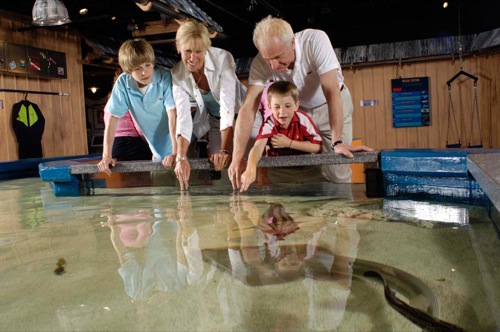
Courtesy Newport Aquarium
Have you ever wanted to pet the slick, sleek feathers of a penguin? Or come nose to blowhole with a beluga whale? How about shaking flippers with a harbor seal?
Aquariums around the country offer visitors opportunities to meet, greet and touch exotic marine animals with the hope that these up-close encounters will bridge the gap between human and animal and, by doing so, create a lifelong connection with the creatures and the efforts to conserve them.
Newport Aquarium
Newport, Kentucky
“Everyone loves penguins,” and Penguin Encounters is Newport Aquarium’s most-popular hands-on program, said exhibit operations manager Erin Cochrane.
“We see all kinds of people who are avid penguin-lovers,” she said.
Guests enter the Penguin House for the 20-minute program, in which animal specialists talk about and handle African penguins and give visitors a chance to touch them.
“Our African penguins are very friendly,” Cochrane said. “They’ve been around people since they were hatched.”
The aquarium also offers daily Behind-the-Scenes tours. Guides take groups into areas that are generally off-limits, such as one of the major kitchens, the veterinarian lab, and the dive station and acclimation area, which is a “great way to demonstrate how we transport animals to and from the aquarium and how we get them into the tanks,” Cochrane said.
Because what happens on the other side of the exhibits changes from day to day, “you’re never going to get the same tour twice,” she added.
General admission tickets also include access to several immersive, hands-on exhibits. In the Shark Central petting pool, visitors can pet eight different shark species, including the ever-popular guitar shark, or they can stop in the rain forest gallery, buy a cup of nectar and feed the birds. Visitors can also touch horseshoe crabs, spider crabs, sea stars, urchins and whelks in the tidal pool.
www.newportaquarium.com
Mystic Aquarium
Mystic, Connecticut
Imagine wading waist-deep into water and having an alabaster-white whale come up to you for a belly rub. That happens during Mystic Aquarium’s Beluga Encounter program.
“We get feedback from people saying it’s one of the most memorable experiences they’ve ever had,” said spokeswoman Erin Merz.
Because beluga whales are an Arctic species, it’s rare that the average person would have the opportunity to see one in the wild. But during the 90-minute beluga session, trainers lead up to six participants — wearing waterproof gear — into the Arctic Coast exhibit, where guests can touch the whale’s back and belly and learn how whales breathe, spout and “sing.”
For those who want to meet the whales but don’t want to or can’t get into the water, Whales Up Close allows visitors to watch a feeding, get close to the whales and maybe even touch one, all while separated from the belugas by a three-foot-high clear barrier.
Guests can also meet an African penguin during an hourlong Penguin Encounter program. The trainer teaches up to 10 participants how to approach the bird in order to touch it, and near the end of the session, each person can have a one-on-one encounter with the penguin while the trainer holds it.
Mystic Aquarium also includes several hands-on exhibits in the general admission, among them touching rays in the Ray Touch Pool, feeding parakeets and cockatiels in the Birds of the Outback area, and petting a white-spotted bamboo shark in the shark pool.
www.mysticaquarium.org
Monterey Bay Aquarium
Monterey, California
At Monterey Bay Aquarium, the Monterey Bay itself is one the largest and most fascinating exhibits. Visitors may spot humpback whales swimming in the bay or help researchers track sea otters.
The aquarium’s otter exhibit will reopen in late March after renovations; in the meantime, visitors are flocking to the new Otter Spotter station on the outside deck where they use binoculars and telescopes to help observe and track otters in the bay. The Otter Spotter station also allows guests to participate in research by using a receiver to pick up signals from transmitters that aquarium researchers have implanted in wild otters.
“We’re trying to connect people with the animals in the exhibits and the animals in the wild,” said communications director Ken Peterson. “It’s not just seeing that animal; it’s a whole different way of knowing that animal.”
During the Feed the Fish tour, visitors see the food room, learn about different feeding methods and help staff feed fish and kelp forest animals. The Feeding Frenzy tour begins before the aquarium opens to the public, and participants help with “morning rounds.” They learn what different animals eat, help staff prepare breakfast and even feed some animals.
On a behind-the-scenes tour, visitors get to see exhibits from the other side of the glass, peek into a food-prep room and look into the veterinarian lab — and maybe even go in. If, say, a sea otter is getting a routine physical, the vet may invite the group in to see and touch the otter.
“There’s such a culture here of touching,” Peterson said. “What really makes these tours so special is they get to see and participate in whatever cool thing that’s going on that day.”
Monterey Bay Aquarium also has two “huge” touch pools, Peterson said, and offers guests a chance to touch a non-stinging jellyfish during its Jellies tour.











